The Role of Natural Gas and Renewable Energy in Curbing Carbon Emission: Case Study of the United States
Abstract
:1. Introduction
2. Literature Review
3. Materials and Methods
3.1. Model Equation
3.1.1. Cointegration Analysis
3.1.2. Granger Causality Test
3.2. Data Source
4. Analysis Results
4.1. Augmented Dickey-Fuller Unit Root Test
4.2. Johansen Cointegration Test
4.3. Optimal Lag Order
4.4. The Granger Causality Results
4.5. Variance Decomposition
4.6. Impulse Responses Analysis
5. Conclusions and Policy Implications
Acknowledgments
Author Contributions
Conflicts of Interest
References
- O’connor, R.E.; Bord, R.J.; Fisher, A. Risk perceptions, general environmental beliefs, and willingness to address climate change. Risk Anal. 1999, 19, 461–471. [Google Scholar] [CrossRef]
- Pielke, R.; Prins, G.; Rayner, S.; Sarewitz, D. Climate change 2007: Lifting the taboo on adaptation. Nature 2007, 445, 597–598. [Google Scholar] [CrossRef] [PubMed]
- Hotchkiss, E.; Hall, R., Jr.; Sponseller, R.; Butman, D.; Klaminder, J.; Laudon, H.; Rosvall, M.; Karlsson, J. Sources of and processes controlling CO2 emissions change with the size of streams and rivers. Nat. Geosci. 2015, 8, 696–699. [Google Scholar] [CrossRef]
- Menyah, K.; Wolde-Rufael, Y. CO2 emissions, nuclear energy, renewable energy and economic growth in the US. Energy Policy 2010, 38, 2911–2915. [Google Scholar] [CrossRef]
- Adamantiades, A.; Kessides, I. Nuclear power for sustainable development: Current status and future prospects. Energy Policy 2009, 37, 5149–5166. [Google Scholar] [CrossRef]
- DeCanio, S.J. The political economy of global carbon emissions reductions. Ecol. Econ. 2009, 68, 915–924. [Google Scholar] [CrossRef]
- Reddy, B.S.; Assenza, G.B. The great climate debate. Energy Policy 2009, 37, 2997–3008. [Google Scholar] [CrossRef]
- Vitousek, P.M.; Mooney, H.A.; Lubchenco, J.; Melillo, J.M. Human domination of Earth’s ecosystems. Science 1997, 277, 494–499. [Google Scholar] [CrossRef]
- Hansen, J.; Sato, M. Regional climate change and national responsibilities. Environ. Res. Lett. 2016, 11, 034009. [Google Scholar] [CrossRef]
- Wang, Q.; Li, R. Journey to burning half of global coal: Trajectory and drivers of China׳s coal use. Renew. Sustain. Energy Rev. 2016, 58, 341–346. [Google Scholar] [CrossRef]
- Wang, Q.; Li, R. Drivers for energy consumption: A comparative analysis of China and India. Renew. Sustain. Energy Rev. 2016, 62, 954–962. [Google Scholar] [CrossRef]
- Wang, Q.; Li, R. Natural gas from shale formation: A research profile. Renew. Sustain. Energy Rev. 2016, 57, 1–6. [Google Scholar] [CrossRef]
- Wang, Q.; Chen, X.; Jha, A.N.; Rogers, H. Natural gas from shale formation–the evolution, evidences and challenges of shale gas revolution in United States. Renew. Sustain. Energy Rev. 2014, 30, 1–28. [Google Scholar] [CrossRef]
- Wang, Q.; Li, R. Research status of shale gas: A review. Renew. Sustain. Energy Rev 2017, 74, 715–720. [Google Scholar] [CrossRef]
- Hughes, J.D. Energy: A reality check on the shale revolution. Nature 2013, 494, 307–308. [Google Scholar] [CrossRef] [PubMed]
- IPCC. Contribution of Working Group III to the Fourth Assessment Report of the Intergovernmental Panel on Climate Change Cambridge; Climate Change 2007; Cambridge University Press: London, UK, 2007. [Google Scholar]
- O’Neill, B.C.; Oppenheimer, M.; Warren, R.; Hallegatte, S.; Kopp, R.E.; Pörtner, H.O.; Scholes, R.; Birkmann, J.; Foden, W.; Licker, R. IPCC reasons for concern regarding climate change risks. Nat. Climate Chang. 2017, 7, 28–37. [Google Scholar] [CrossRef]
- BP Statistical Review of World Energy. Available online: http://www.bp.com/en/global/corporate/energy-economics/statistical-review-of-world-energy.html (accessed on 10 April 2017).
- Sakata, M.; Phan, H.G.; Mitsunobu, S. Variations in atmospheric concentrations and isotopic compositions of gaseous and particulate boron in Shizuoka City, Japan. Atmos. Environ. 2017, 148, 376–381. [Google Scholar] [CrossRef]
- Lee, J.S.; Won, D.I.; Jung, W.J.; Son, H.J.; Pac, C.; Kang, S.O. Widely controllable syngas production by a dye-sensitized TiO2 hybrid system with ReI and CoIII catalysts under visible-light irradiation. Angew. Chem. Int. Ed. 2017, 56, 976–980. [Google Scholar] [CrossRef] [PubMed]
- Friedl, B.; Getzner, M. Determinants of CO2 emissions in a small open economy. Ecol. Econ. 2003, 45, 133–148. [Google Scholar] [CrossRef]
- Menyah, K.; Wolde-Rufael, Y. Energy consumption, pollutant emissions and economic growth in South Africa. Energy Econom. 2010, 32, 1374–1382. [Google Scholar] [CrossRef]
- Sharma, S.S. Determinants of carbon dioxide emissions: Empirical evidence from 69 countries. Appl. Energy 2011, 88, 376–382. [Google Scholar] [CrossRef]
- Dogan, E.; Seker, F. Determinants of CO2 emissions in the European Union: The role of renewable and non-renewable energy. Renew. Energy 2016, 94, 429–439. [Google Scholar] [CrossRef]
- Saidi, K.; Mbarek, M.B. Nuclear energy, renewable energy, CO2 emissions, and economic growth for nine developed countries: Evidence from panel Granger causality tests. Prog. Nucl. Energy 2016, 88, 364–374. [Google Scholar] [CrossRef]
- Zoundi, Z. CO2 emissions, renewable energy and the Environmental Kuznets Curve, a panel cointegration approach. Renew. Sustain. Energy Rev. 2016. [Google Scholar] [CrossRef]
- Wang, Q.; Li, R. Impact of cheaper oil on economic system and climate change: A SWOT analysis. Renew. Sustain. Energy Rev. 2016, 54, 925–931. [Google Scholar] [CrossRef]
- Wang, Q.; Chen, X. Energy policies for managing China’s carbon emission. Renew. Sustain. Energy Rev. 2015, 50, 470–479. [Google Scholar] [CrossRef]
- Wang, Q. Effective policies for renewable energy—The example of China’s wind power—Lessons for China’s photovoltaic power. Renew. Sustain. Energy Rev. 2010, 14, 702–712. [Google Scholar] [CrossRef]
- Wang, Q. Cheaper oil challenge and opportunity for climate change. Environ. Sci. Technol. 2015, 49, 1997–1998. [Google Scholar] [CrossRef] [PubMed]
- Wang, Q.; Li, R. Cheaper oil: A turning point in Paris climate talk? Renew. Sustain. Energy Rev. 2015, 52, 1186–1192. [Google Scholar] [CrossRef]
- Wang, Q. Nuclear safety lies in greater transparency. Nature 2013, 494, 403. [Google Scholar] [CrossRef] [PubMed]
- Wang, Q.; Li, R. Sino-Venezuelan oil-for-loan deal—The Chinese strategic gamble? Renew. Sustain. Energy Rev. 2016, 64, 817–822. [Google Scholar] [CrossRef]
- Wang, Q. China needs workers more than academics. Nature 2013, 499, 381. [Google Scholar] [CrossRef] [PubMed]
- Searchinger, T.; Heimlich, R.; Houghton, R.A.; Dong, F.; Elobeid, A.; Fabiosa, J.; Tokgoz, S.; Hayes, D.; Yu, T.-H. Use of US croplands for biofuels increases greenhouse gases through emissions from land-use change. Science 2008, 319, 1238–1240. [Google Scholar] [CrossRef] [PubMed]
- Houghton, R.; Hackler, J.; Lawrence, K. The US carbon budget: Contributions from land-use change. Science 1999, 285, 574–578. [Google Scholar] [CrossRef] [PubMed]
- Fargione, J.; Hill, J.; Tilman, D.; Polasky, S.; Hawthorne, P. Land clearing and the biofuel carbon debt. Science 2008, 319, 1235–1238. [Google Scholar] [CrossRef] [PubMed]
- Hertel, T.W.; Golub, A.A.; Jones, A.D.; O’Hare, M.; Plevin, R.J.; Kammen, D.M. Effects of US maize ethanol on global land use and greenhouse gas emissions: Estimating market-mediated responses. BioScience 2010, 60, 223–231. [Google Scholar] [CrossRef]
- Lal, R. Carbon emission from farm operations. Environ. Int. 2004, 30, 981–990. [Google Scholar] [CrossRef] [PubMed]
- McCarl, B.A.; Schneider, U.A. Greenhouse gas mitigation in US agriculture and forestry. Science 2001, 294, 2481–2482. [Google Scholar] [CrossRef] [PubMed]
- Weber, C.L.; Matthews, H.S. Embodied environmental emissions in US international trade, 1997−2004. Environ. Sci. Technol. 2007, 41, 4875–4881. [Google Scholar] [PubMed]
- Soytas, U.; Sari, R.; Ewing, B.T. Energy consumption, income, and carbon emissions in the United States. Ecol. Econ. 2007, 62, 482–489. [Google Scholar] [CrossRef]
- Menegaki, A.N.; Tiwari, A.K. The index of sustainable economic welfare in the energy-growth nexus for American countries. Ecol. Indic. 2017, 72, 494–509. [Google Scholar] [CrossRef]
- Armitage, C.J.; Conner, M. Efficacy of the theory of planned behaviour: A meta-analytic review. Br. J. Soc. Psychol. 2001, 40, 471–499. [Google Scholar] [CrossRef] [PubMed]
- Martin, D.J.; Garske, J.P.; Davis, M.K. Relation of the therapeutic alliance with outcome and other variables: A meta-analytic review. J. Consult. Clin. Psychol. 2000, 68, 438–450. [Google Scholar] [CrossRef] [PubMed]
- Sims, R. Renewable energy: A response to climate change. Sol. Energy 2004, 76, 9–17. [Google Scholar] [CrossRef]
- Sims, R.E.H.; Rogner, H.H.; Gregory, K. Carbon emission and mitigation cost comparisons between fossil fuel, nuclear and renewable energy resources for electricity generation. Energy Policy 2003, 31, 1315–1326. [Google Scholar] [CrossRef]
- Perry, S.; Klemeš, J.; Bulatov, I. Integrating waste and renewable energy to reduce the carbon footprint of locally integrated energy sectors. Energy 2008, 33, 1489–1497. [Google Scholar] [CrossRef]
- De Oliveira, M.E.D.; Vaughan, B.E.; Rykiel, E.J. Ethanol as fuel: Energy, carbon dioxide balances, and ecological footprint. BioScience 2005, 55, 593–602. [Google Scholar] [CrossRef]
- Vehmas, J.; Luukkanen, J.; Kaivo-oja, J. Linking analyses and environmental Kuznets curves for aggregated material flows in the EU. J. Clean. Prod. 2007, 15, 1662–1673. [Google Scholar] [CrossRef]
- Panwar, N.; Kaushik, S.; Kothari, S. Role of renewable energy sources in environmental protection: A review. Renew. Sustain. Energy Rev. 2011, 15, 1513–1524. [Google Scholar] [CrossRef]
- Sadorsky, P. Renewable energy consumption, CO2 emissions and oil prices in the G7 countries. Energy Econ. 2009, 31, 456–462. [Google Scholar] [CrossRef]
- Bowden, N.; Payne, J.E. Sectoral analysis of the causal relationship between renewable and non-renewable energy consumption and real output in the US. Energy Sources Part B Econ. Plan. Policy 2010, 5, 400–408. [Google Scholar] [CrossRef]
- Apergis, N.; Payne, J.E. Renewable energy consumption and economic growth: Evidence from a panel of OECD countries. Energy Policy 2010, 38, 656–660. [Google Scholar] [CrossRef]
- Menegaki, A.N.; Tsagarakis, K.P. Rich enough to go renewable, but too early to leave fossil energy? Renew. Sustain. Energy Rev. 2015, 41, 1465–1477. [Google Scholar] [CrossRef]
- Marques, A.C.; Fuinhas, J.A.; Menegaki, A.N. Renewable vs non-renewable electricity and the industrial production nexus: Evidence from an ARDL bounds test approach for Greece. Renew. Energy 2016, 96, 645–655. [Google Scholar] [CrossRef]
- Menegaki, A.N.; Ozturk, I. Renewable energy, rents and GDP growth in MENA countries. Energy Sour. Part B: Econ.Plan. Policy 2014. [Google Scholar] [CrossRef]
- Saidi, K.; Mbarek Mbarek, M.B.; Saidi, K. How Effective Are Renewable Energy in Addition of Economic Growth and Curbing CO2 Emissions in the Long Run? A Panel Data Analysis for Four Mediterranean Countries. J. Knowl. Econom. 2016. [Google Scholar] [CrossRef]
- Baek, J. Do nuclear and renewable energy improve the environment? Empirical evidence from the United States. Ecol. Indic. 2016, 66, 352–356. [Google Scholar] [CrossRef]
- Wang, Q.; Li, R.; Jiang, R. Decoupling and Decomposition Analysis of Carbon Emissions from Industry: A Case Study from China. Sustainability 2016, 8, 1059. [Google Scholar] [CrossRef]
- Wang, Q.; Jiang, X.-T.; Li, R. Comparative decoupling analysis of energy-related carbon emission from electric output of electricity sector in Shandong Province, China. Energy 2017, 127, 78–88. [Google Scholar] [CrossRef]
- Wang, Q.; Chen, X. China’s electricity market-oriented reform: From an absolute to a relative monopoly. Energy Policy 2012, 51, 143–148. [Google Scholar] [CrossRef]
- Burbidge, J.; Harrison, A. Testing for the effects of oil-price rises using vector autoregressions. Int. Econ. Rev. 1984, 459–484. [Google Scholar] [CrossRef]
- Wang, Y.; Zhang, Q.; Wang, J. Analysis of influencing factors of oil consumption in China based on VAR model. J. Shenyang Univ. Technol. (Soc. Sci. Ed.) 2017, 10. [Google Scholar] [CrossRef]
- Toda, H.Y.; Yamamoto, T. Statistical inference in vector autoregressions with possibly integrated processes. J. Econ. 1995, 66, 225–250. [Google Scholar] [CrossRef]
- Granger, C.W. Some recent development in a concept of causality. J. Econ. 1988, 39, 199–211. [Google Scholar] [CrossRef]
- MacKinnon, J.G. Numerical distribution functions for unit root and cointegration tests. J. Appl. Econ. 1996, 601–618. [Google Scholar] [CrossRef]
- Lee, J.; Strazicich, M.C. Minimum lagrange multiplier unit root test with two structural breaks. Rev. Econ. Stat. 2003, 85, 1082–1089. [Google Scholar] [CrossRef]
- Crowder, W.J.; Hamed, A. A cointegration test for oil futures market efficiency. J. Futures Mark. 1993, 13, 933–941. [Google Scholar] [CrossRef]
- Maddala, G.S.; Kim, I.-M. Unit Roots, Cointegration, and Structural Change; Cambridge University Press: Cambridge, UK, 1998. [Google Scholar]
- Christopoulos, D.K.; Tsionas, E.G. Financial development and economic growth: Evidence from panel unit root and cointegration tests. J. Dev. Econ. 2004, 73, 55–74. [Google Scholar] [CrossRef]
- Pesaran, M.H.; Shin, Y. An autoregressive distributed-lag modelling approach to cointegration analysis. Econ. Soc. Monogr. 1998, 31, 371–413. [Google Scholar]
- Narayan, P.K. The saving and investment nexus for China: Evidence from cointegration tests. Appl. Econ. 2005, 37, 1979–1990. [Google Scholar] [CrossRef]
- Guo, J. Dynamic Analysis of the Energy Economy and Study on the Energy Efficiency. Ph.D. Thesis, Tianjin University, Tianjin, China, June 2007. [Google Scholar]
- Campbell, J.Y.; Ammer, J. What moves the stock and bond markets? A variance decomposition for long-term asset returns. J. Financ. 1993, 48, 3–37. [Google Scholar] [CrossRef]
- Wang, Q. China has the capacity to lead in carbon trading. Nature 2013, 493, 273. [Google Scholar] [CrossRef] [PubMed]
- Wang, Q. China should aim for a total cap on emissions. Nature 2014, 512, 115. [Google Scholar] [CrossRef] [PubMed]
- Wang, Q. China’s citizens must act to save their environment. Nature 2013, 497, 159. [Google Scholar] [CrossRef] [PubMed]
- Wang, Q.; Li, R.; Hua, L. Toward decoupling: Growing GDP without growing carbon emissions. Environ. Sci. Technol. 2016, 50, 11435. [Google Scholar] [CrossRef] [PubMed]

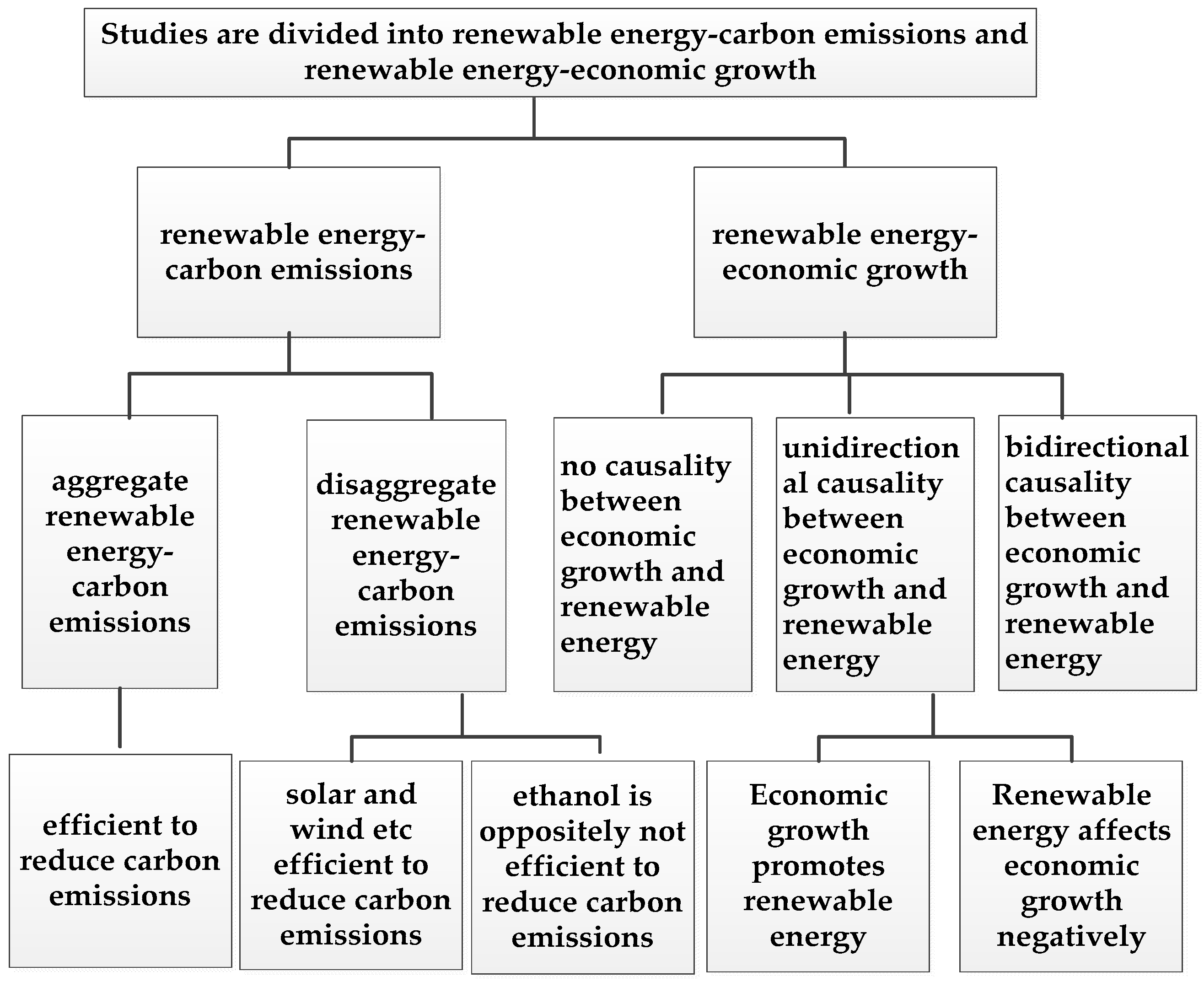
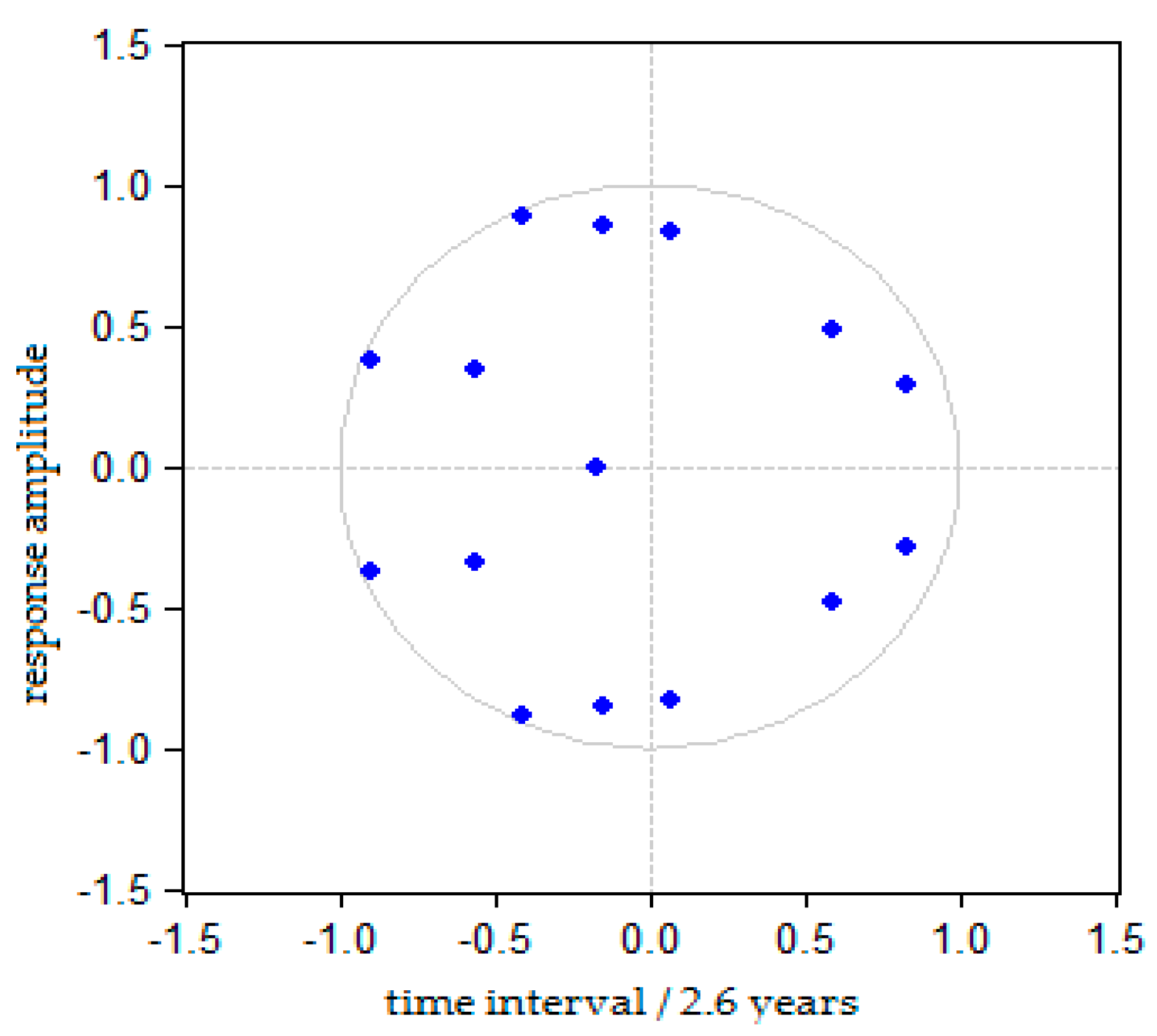
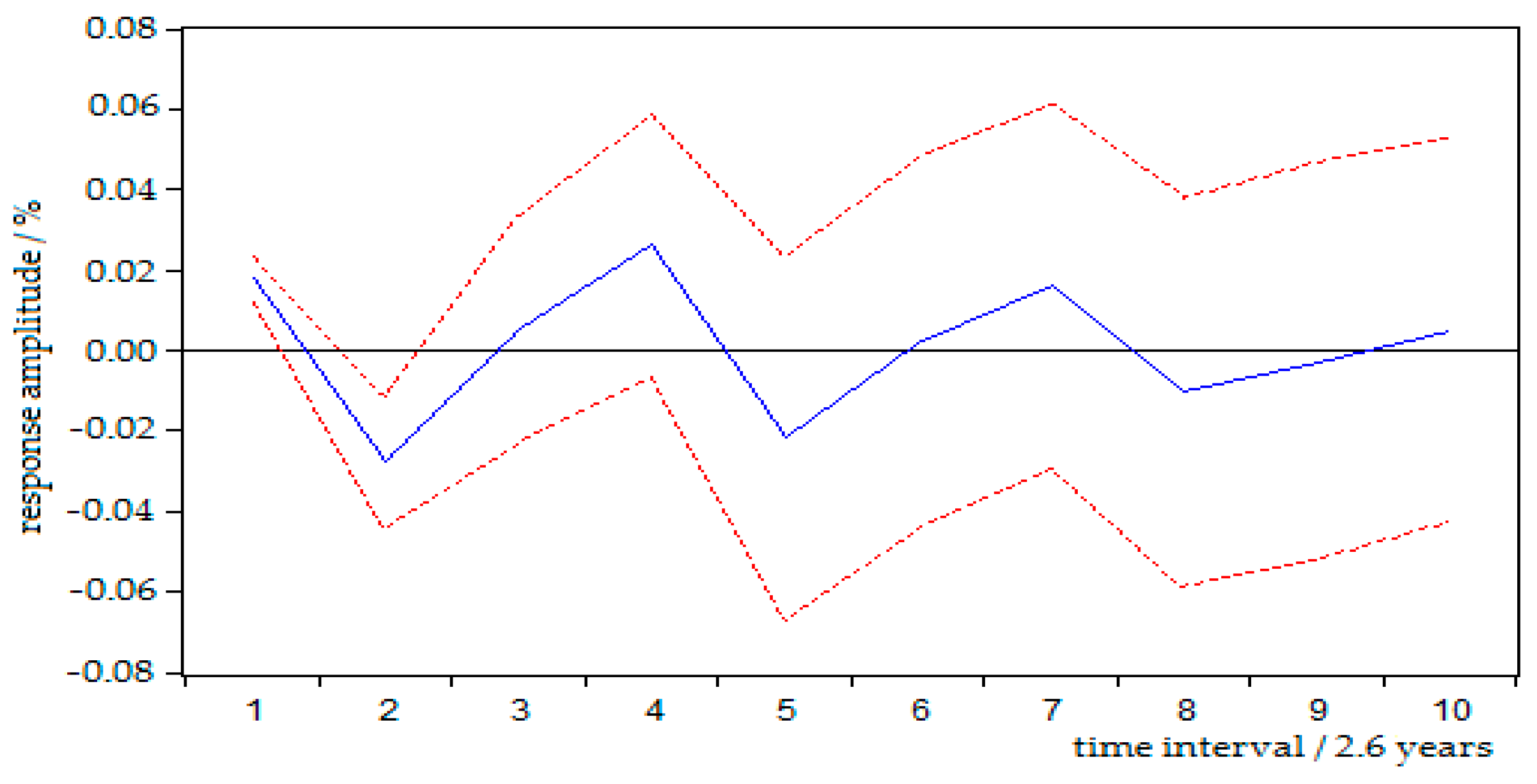

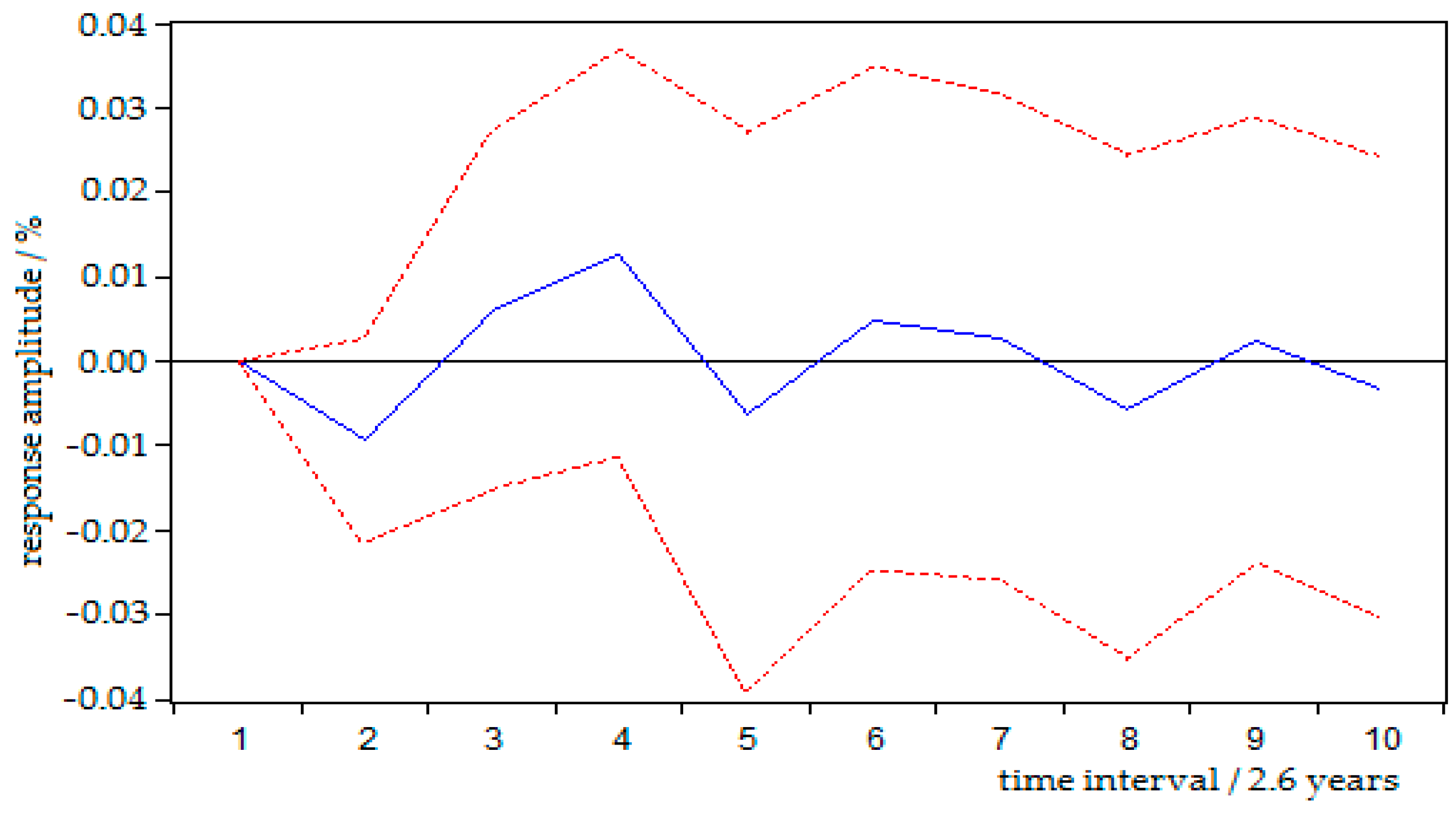
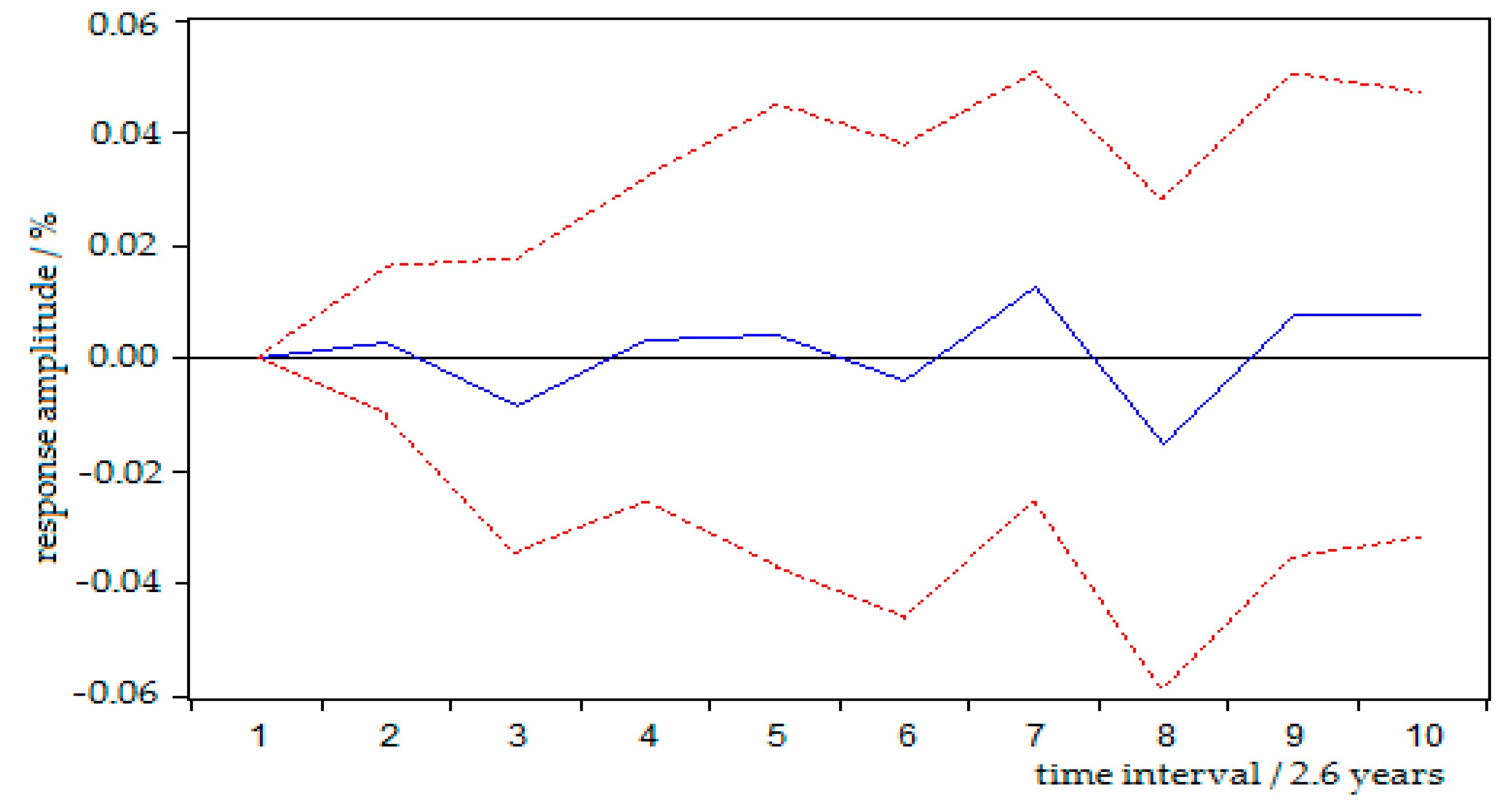
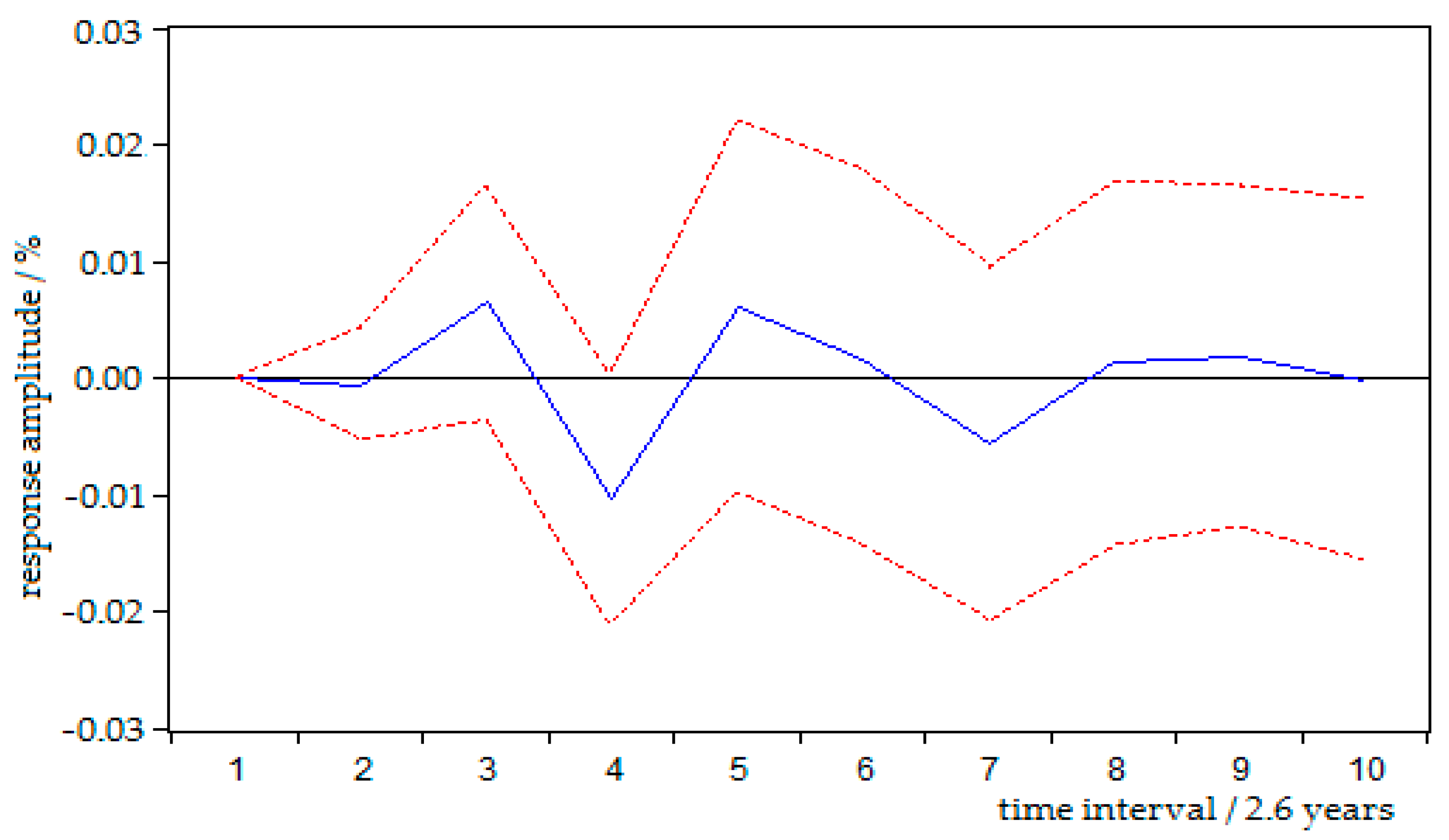
| Study | Data-Span | Method | Country | Variables Used | Major Findings |
|---|---|---|---|---|---|
| Renewable energy: a response to climate change [46] | 2010–2020 | Scenario analysis | The world | CO2 emissions, the cost and amount of renewable energy | CO2 reduction potential is from renewable energy |
| Carbon emission and mitigation cost comparisons between fossil fuel nuclear and renewable energy resources for electricity generation [47] | 2010 and 2020 | Scenario analysis | Annex I and non-Annex I countries | Energy source; generating costs; emissions; cost of C reduction; reduction potential to 2010; reduction potential to 2020 | Greater use of renewable energy is efficient to reduce CO2 emissions |
| Integrating waste and renewable energy to reduce the carbon footprint of locally integrated energy sectors [48] | 2008 | Total site targeting methodology | UK | Carbon footprint; combined heat and power generation; process stream supply temperature, etc. | Integrate renewables into the energy source mix and consequently reduce carbon emissions |
| Ethanol as fuel: energy, carbon dioxide balances, and ecological footprint [49] | 2001 | STELLA model | Brazil and US | Ethanol production; CO2 emissions | Accompanying environmental impacts of use of ethanol outweigh its benefits |
| Plug-in vehicles and renewable energy sources for cost and emission reductions [50] | 2011 | Smart grid model | The world | Renewable energy, mainly wind and solar, CO2 emission from the electricity industry | Renewable energy can reduce emissions from the electricity industry |
| Role of renewable energy sources in environmental protection: a review [51] | 2001, 2010, 2020, 2030, 2040 | Scenario analysis | The world | Main renewable energy sources; CO2 emissions | Renewable energy is an excellent opportunity for the mitigation of greenhouse gas emissions |
| CO2 emissions, nuclear energy, renewable energy and economic growth in the US [4] | 1960–2007 | Granger causality test | US | CO2 emissions; renewable energy | Renewable energy consumption did not help in mitigating CO2 emissions |
| Study | Data-Span | Method | Country | Variables Used | Major Findings |
|---|---|---|---|---|---|
| CO2 emissions, nuclear energy, renewable energy and economic growth in the US [4] | 1960–2007 | Granger causality test | US | Economic growth; renewable energy | Economic growth promotes renewable energy consumption |
| Renewable energy consumption, CO2 emissions and oil prices in the G7 countries [52] | 1980–2005 | Panel cointegration | G7 countries | Renewable energy; income elasticity; CO2; oil prices | Economic growth is an important driver of renewable energy consumption |
| Sectoral analysis of the causal relationship between renewable and non-renewable energy consumption and real output in the US [53] | 1949–2006 | Toda-Yamamoto long-run causality tests | US | GDP; renewable energy | No causality between GDP and renewable energy |
| Renewable energy consumption and economic growth: evidence from a panel of OECD countries [54] | 1985–2005 | cointegration test | OECD countries | Economic growth; renewable energy | Bidirectional causality between renewable energy consumption and economic growth in both the short- and long-run |
| Rich enough to go renewable, but too early to leave fossil energy? [55] | 1990–2010 | Random effect Arellano Bond estimator models | 33 European members | Renewable energy production; GDP per capita | Economic growth causes consecutive rebounds to renewable energy development |
| Renewable vs non-renewable electricity and the industrial production nexus: Evidence from an ARDL bounds test approach for Greece [56] | August. 2004 to February 2014 | Autoregressive Distributed Lag bounds test | Greece | Renewable and non-renewableelectricity; economic growth | In the short-run, fossil sources play the baseload role in electricity production; in the long-run, fossil sources contribute to the development of renewable energy sources |
| Renewable energy, rents and GDP growth in MENA countries [57] | 1997–2009 | Dynamic, fixed effects model | MENA countries | Renewable energy; GDP growth; employment, etc. | Renewable energy affects GDP growth negatively in the long-run |
| Variable | Mean | Std. Dev. | Min | Max |
|---|---|---|---|---|
| 5675.5787 | 298.4913 | 5117.4537 | 6132.4197 | |
| 92.0171 | 16.8601 | 66.3806 | 129.1542 | |
| 12,974,847 | 2,415,938 | 9,057,698 | 16,597,445 | |
| 2221.3920 | 120.8930 | 1965.0325 | 2371.8237 | |
| 589.1269 | 52.5359 | 493.9915 | 713.6022 |
| Variable | Mean | Std. Dev. | Min | Max |
|---|---|---|---|---|
| 1.002747 | 0.024951 | 0.928739 | 1.040659 | |
| 1.022648 | 0.091738 | 0.822833 | 1.201531 | |
| 1.024629 | 0.017075 | 0.972245 | 1.046852 | |
| 1.006129 | 0.020396 | 0.950802 | 1.035899 | |
| 1.015160 | 0.026657 | 0.955867 | 1.064033 |
| Variable | Level | First Difference | Second Difference | |||
|---|---|---|---|---|---|---|
| t-Statistic | Prob. * | t-Statistic | Prob. * | t-Statistic | Prob. * | |
| Ln | −1.841293 | 0.3530 | −1.566869 | 0.4820 | −8.972583 | 0.0000 |
| Ln | −2.308182 | 0.1772 | −1.617599 | 0.4572 | −9.101436 | 0.0000 |
| Ln | −0.545182 | 0.8659 | −5.358222 | 0.0002 | – | – |
| Ln | −0.376888 | 0.8989 | −5.399738 | 0.0002 | – | – |
| Ln | −1.823769 | 0.3609 | −3.177550 | 0.0341 | – | – |
| Hypothesized No. of CE(S) | Eigenvalue | Trace Statistic | 0.05 Critical Value | Prob. ** |
|---|---|---|---|---|
| None * | 0.919073 | 115.7581 | 69.81889 | 0.0000 |
| At most 1 * | 0.742273 | 60.44548 | 47.85613 | 0.0021 |
| At most 2 * | 0.604860 | 30.61668 | 29.79707 | 0.0402 |
| At most 3 | 0.270599 | 10.18937 | 15.49471 | 0.2665 |
| At most 4 | 0.137243 | 3.247687 | 3.841466 | 0.0715 |
| Lag | LogL | LR | FPE | AIC | SC | HQ |
|---|---|---|---|---|---|---|
| 0 | 235.1871 | NA | 2.07 × 10−16 | −21.92258 | −21.67388 | −21.86860 |
| 1 | 271.2822 | 51.56453 * | 7.82 × 10−17 | −22.97926 | −21.48708 | −22.65542 |
| 2 | 301.7092 | 28.97807 | 7.66 × 10−17 | −23.49611 | −20.76046 | −22.90241 |
| 3 | 357.7041 | 26.66423 | 2.45 × 10−17 * | −26.44801 * | −22.46887 * | −25.58443 * |
| Variable | Coefficient | Std. Error | t-Statistic | Prob |
|---|---|---|---|---|
| Ln | −0.045808 | 0.028137 | −1.628034 | 0.1200 |
| Ln | 0.105815 | 0.163473 | 0.647292 | 0.5252 |
| Ln | 1.127493 | 0.098137 | 11.48901 | 0.0000 |
| Ln | 0.044435 | 0.109412 | 0.406130 | 0.6892 |
| c | −0.002813 | 0.005133 | −0.548125 | 0.5900 |
| Dependent Variable | Ln | Ln | Ln | Ln | Ln |
|---|---|---|---|---|---|
| Ln | – | 0.2006 (1.76849) | 0.5638 (0.59287) | 0.5717 (0.57788) | 0.6972 (0.36845) |
| Ln | 0.7432 (0.30210) | – | 0.7497 (0.29297) | 0.6944 (0.37219) | 0.0250 (4.55736) |
| Ln | 0.6227 (0.48718) | 0.3317 (1.17851) | – | 0.2786 (1.37918) | 0.4816 (0.76297) |
| Ln | 0.7634 (0.27424) | 0.7132 (0.34444) | 0.9208 (0.08290) | – | 0.5750 (0.57069) |
| Ln | 0.6465 (0.44763) | 0.2785 (1.37351) | 0.8012 (0.22459) | 0.2513 (1.49263) | – |
| Period | S.E. | Ng | pe | re | y | |
|---|---|---|---|---|---|---|
| 1 | 0.025133 | 100.0000 | 0.000000 | 0.000000 | 0.000000 | 0.000000 |
| 2 | 0.039725 | 89.43859 | 1.449627 | 5.034572 | 2.776565 | 1.300651 |
| 3 | 0.042684 | 78.92087 | 1.571097 | 11.28675 | 2.435458 | 5.785829 |
| 4 | 0.047363 | 71.65297 | 4.225139 | 9.598777 | 6.036759 | 8.486356 |
| 5 | 0.049212 | 70.77241 | 5.112457 | 9.706330 | 6.536472 | 7.872331 |
| 6 | 0.049934 | 69.66817 | 4.990904 | 10.29472 | 6.665203 | 8.380999 |
| 7 | 0.051677 | 69.45335 | 5.462661 | 9.636757 | 7.444748 | 8.002480 |
| 8 | 0.052093 | 68.96800 | 5.500810 | 10.03408 | 7.357998 | 8.139121 |
| 9 | 0.052631 | 68.50340 | 5.542318 | 10.00261 | 7.612963 | 8.338717 |
| 10 | 0.053133 | 68.47273 | 5.693212 | 9.876224 | 7.771473 | 8.186361 |
© 2017 by the authors. Licensee MDPI, Basel, Switzerland. This article is an open access article distributed under the terms and conditions of the Creative Commons Attribution (CC BY) license (http://creativecommons.org/licenses/by/4.0/).
Share and Cite
Li, R.; Su, M. The Role of Natural Gas and Renewable Energy in Curbing Carbon Emission: Case Study of the United States. Sustainability 2017, 9, 600. https://doi.org/10.3390/su9040600
Li R, Su M. The Role of Natural Gas and Renewable Energy in Curbing Carbon Emission: Case Study of the United States. Sustainability. 2017; 9(4):600. https://doi.org/10.3390/su9040600
Chicago/Turabian StyleLi, Rongrong, and Min Su. 2017. "The Role of Natural Gas and Renewable Energy in Curbing Carbon Emission: Case Study of the United States" Sustainability 9, no. 4: 600. https://doi.org/10.3390/su9040600




